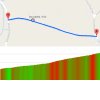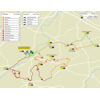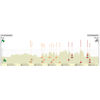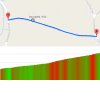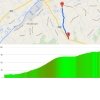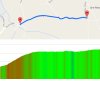The first cobbles appear after 34 kilometres on the Lippehovenstraat. The Paddestraat serves the second sector a little further up the road, while the Katteberg is the first ‘helling’ after 55 kilometres.
The easygoing opener of de Ronde is now history and the Katteberg almost coincides with the cobbled Holleweg. Via the Edelare climb and the Boigneberg the route continues onto the cobbles of Karel Martelstraat and Jagerij, and over the ‘hellingen’ of Molenberg, Marlboroughstraat, Berendries and Valkenberg.
With still 50 kilometres and six climbs to go the attrition race has taken its toll when the riders enter the decisive phase. Berg Ten Houte (1,100 metres at 6%) and Kanarieberg (1,000 metres at 7.7%) lead onto the Taaienberg (530 metres at 6.6%).
And on we go, into the finale. The riders tackle the Kruisberg/Hotond (2.500 metres à 5%) with 26 kilometres remaining to continue towards the cobbled and awe-inspiring combo Oude Kwaremont/Paterberg.
In 2018, Anna van der Breggen soloed to victory after attacking at Kruisberg/Hotond, while the decisive moves of 2019 and 2020 happened on the Oude Kwaremont. Two years ago an elite group took shape on the climb before Marta Bastianelli outsprinted Annemiek van Vleuten and Cecilie Uttrup Ludwig on the line, while Chantal van den Broek-Blaak won last year’s edition solo. She attacked just after the Oude Kwaremont and extended her lead to 1 minute on the finish line. Amy Pieters outsprinted Lotte Kopecky for second place.
Both paved with cobbles, the Oude Kwaremont is a 2.2 kilometres climb at 4% and the Paterberg is 360 metres long and excessively steep. The average gradient sits 12.9% and the toughest ramps go up at an unforgiving 20%.
Other interesting reads: results/race report and start list women’s Tour of Flanders 2021.
Tour of Flanders for women 2021: route, profiles, more
Click on the images to zoom
